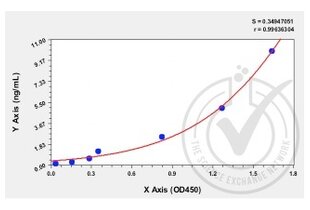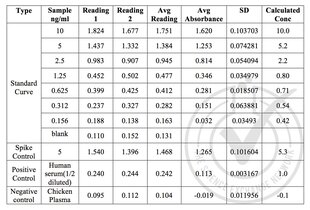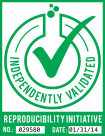Endoglin ELISA Kit
-
- Target Alle Endoglin (ENG) ELISA Kits anzeigen
- Endoglin (ENG)
-
Reaktivität
- Human
- Nachweismethode
- Colorimetric
- Methodentyp
- Sandwich ELISA
- Detektionsbereich
- 0.156-10 ng/mL
- Untere Nachweisgrenze
- 0.156 ng/mL
- Applikation
- ELISA
- Verwendungszweck
- For the quantitative determination of human soluble endoglin (sENG/sCD105) concentrations in serum, plasma, tissue homogenates.
- Proben
- Serum, Plasma, Tissue Homogenate
- Analytische Methode
- Quantitative
- Spezifität
- This assay has high sensitivity and excellent specificity for detection of human sENG.
- Kreuzreaktivität (Details)
- Limited by current skills and knowledge, it is impossible for us to complete the cross-reactivity detection between the target antigen and all analogues for other species. Therefore, cross reaction may still exist.
- Sensitivität
- 0.047 ng/mL
- Bestandteile
-
- Assay plate (12 × 8 coated Microwells)
- Standard (freeze dried)
- Biotin-antibody (100 × concentrate)
- HRP-avidin (100 × concentrate)
- Biotin-antibody Diluent
- HRP-avidin Diluent
- Sample Diluent
- Wash Buffer (25 × concentrate)
- TMB Substrate
- Stop Solution
- Adhesive Strip (for 96 wells)
- Instruction manual
-
-
- Applikationshinweise
-
- The supplier is only responsible for the kit itself, but not for the samples consumed during the assay. The user should calculate the possible amount of the samples used in the whole test. Please reserve sufficient samples in advance.
- Samples to be used within 5 days may be stored at 2-8°C, otherwise samples must be stored at -20°C (≤ 1 month) or -80°C (≤ 2 months) to avoid loss of bioactivity and contamination.
- Grossly hemolyzed samples are not suitable for use in this assay.
- If the samples are not indicated in the manual, a preliminary experiment to determine the validity of the kit is necessary.
- Please predict the concentration before assaying. If values for these are not within the range of the standard curve, users must determine the optimal sample dilutions for their particular experiments.
- Tissue or cell extraction samples prepared by chemical lysis buffer may cause unexpected ELISA results due to the impacts of certain chemicals.
- Owing to the possibility of mismatching between antigens from another resource and antibodies used in this supplier's kits (e.g., antibody targets conformational epitope rather than linear epitope), some native or recombinant proteins from other manufacturers may not be recognized by this supplier's products.
- Influenced by factors including cell viability, cell number and cell sampling time, samples from cell culture supernatant may not be recognized by the kit.
- Fresh samples without long time storage are recommended for the test. Otherwise, protein degradation and denaturalization may occur in those samples and finally lead to wrong results.
- Kommentare
-
Detection wavelength: 450 nm
Information on standard material:
Depending on the antigen to be detected, standards can be either native or recombinant protein. The recombinant proteins are being expressed in CHO cells in most cases. Please inquire for more information. The formulation of auxiliary material in the standard is considered proprietary information, however it does not contain any poisonous substance. Proclin 300 (1:3000) is used as preservative.
Information on reagents:
In most cases the stop solution provided is 1 N H2SO4. The formulation of wash solution is proprietary information. None of the components contain (sodium) azide, thimerosal, 2-mercaptoethanol (2-ME) or any other poisonous materials. For the sandwich method kits, the sample diluent, antibody diluent, enzyme diluent and standard all contain BSA.
Information on antibodies:
The antibodies provided in different kits vary in regards to clonality and host. Some antibodies are affinity purified, some are Protein A - Probenmenge
- 100 μL
- Testdauer
- 1 - 4.5 h
- Plattentyp
- Pre-coated
- Protokoll
- This assay employs the quantitative sandwich enzyme immunoassay technique. Antibody specific for sENG has been pre-coated onto a microplate. Standards and samples are pipetted into the wells and any sENG present is bound by the immobilized antibody. After removing any unbound substances, a biotin-conjugated antibody specific for sENG is added to the wells. After washing, avidin conjugated Horseradish Peroxidase (HRP) is added to the wells. Following a wash to remove any unbound avidin-enzyme reagent, a substrate solution is added to the wells and color develops in proportion to the amount of sENG bound in the initial step. The color development is stopped and the intensity of the color is measured.
- Aufbereitung der Reagenzien
-
- Biotin-antibody (1×) - Centrifuge the vial before opening.
Biotin-antibody requires a 100-fold dilution. The suggested dilution is 10µL of Biotin-antibody + 990µL of Biotin-antibody Diluent. - HRP-avidin (1×) - Centrifuge the vial before opening.
HRP-avidin requires a 100-fold dilution. The suggested dilution is 10µL of HRP-avidin + 990µL of HRP-avidin Diluent. - Wash Buffer (1×) - If crystals have formed in the concentrate, warm up to room temperature and mix gently until the crystals have completely dissolved. Dilute 20mL of Wash Buffer Concentrate (25×) into deionized or distilled water to prepare 500mL of Wash Buffer (1×).
- Standard - Centrifuge the standard vial at 6000-10000rpm for 30s.
Reconstitute the Standard with 1ml of Sample Diluent. Do not substitute other diluents. This reconstitution produces a stock solution of 200pg/mL. Mix the standard to ensure complete reconstitution and allow the standard to sit for a minimum of 15 minutes with gentle agitation prior to making dilutions.
Pipette 250µL of Sample Diluent into each tube. Use the stock solution to produce a 2-fold dilution series. Mix each tube thoroughly before the next transfer. The undiluted Standard serves as the high standard (200pg/mL). Sample Diluent serves as the zero standard (0ng/mL).
- Kindly use graduated containers to prepare the reagent. Please don't prepare the reagent directly in the Diluent vials provided in the kit.
- Bring all reagents to room temperature (18-25°C) before use for 30 min.
- Prepare fresh standard for each assay. Use within 4 hours and discard after use.
- Making serial dilution in the wells directly is not permitted.
- Please carefully reconstitute Standards according to the instruction. Avoid foaming and mix gently until the crystals have completely dissolved. To minimize imprecision caused by pipetting, use small volumes and ensure that pipettors are calibrated. It is recommended to suck more than 10µL when pipetting.
- It is recommended to use distilled water to prepare reagents and samples. Using contaminated water or container for reagent preparation will influence detection result.
- Biotin-antibody (1×) - Centrifuge the vial before opening.
- Testpräzision
-
Intra-assay precision (precision within an assay): Three samples of known concentration were tested twenty times on one plate to assess precision.
Inter-assay precision (precision between assays): Three samples of known concentration were tested in twenty assays to assess precision.- Intra-assay: CV% less than 8%
- Inter-assay: CV% less than 10%
- Beschränkungen
- Nur für Forschungszwecke einsetzbar
-
- by
- Affina Biotechnologies, Inc
- No.
- #029580
- Datum
- 31.01.2014
- Antigen
- Chargennummer
- U13095905
- Validierte Anwendung
- ELISA
- Positivkontrolle
- Human individual post-menopausal female serum
- Negativkontrolle
- chicken plasma
- Bewertung
- Signal was detected in positive control sample and not in negative control sample.
- Primärantikörper
- Antigen: Human CD105 (Endoglin / TGF-Beta1/3 Receptor)
- Catalog number: ABIN366603
- Lot number: U13095905
- Sekundärantikörper
- Full Protocol
- 100 µL of standard and samples were added 96-well strip plates provided in the kit. All samples and standards were assayed in duplicate.
- The microplate was covered and incubated at 37°C for 1 hr.
- Plate contents were discarded.
- 100 µL of biotin antibody conjugate was added and incubated at 37°C for 1 hr. - Content of the wells was discarded and wells were washed 3 times with 200 µl of 1x wash solution with a 2 min soak for each wash.
- 100 µL of HRP-avidin conjugate was added and incubated at 37°C for 1 hr.
- Contents of the wells were discarded and wells were washed 5 times with 200 µl of 1x wash solution with a 2 min soak for each wash.
- 90 µl of TMB substrate was added to each well. The plate was covered and incubated at 37°C for 15 min.
- 50 µl of the Stop Solution was added per well.
- The optical density (OD value) of each well was read immediately using a microplate reader set to 450 nm.
- The duplicate readings for each sample were averaged and the average zero standard optical density subtracted. The corrected average-value was tabulated as Average Absorbance. A standard curve was generated by plotting the mean OD value for each standard on the x-axis against the concentration on the Y-axis using CurveExpert 1.4. A logistic equation was used for the best fit through the points on the graph.
- The CurveExpert Analyze feature was used to calculate human CD105 concentrations of the samples based on their Average Absorbance values.
- Anmerkungen
- Undiluted human serum produced artificially low concentration readings. 2-fold and 4-fold diluted samples showed essentially identical concentration readings.
Validierung #029580 (ELISA)![Erfolgreich validiert 'Independent Validation' Siegel]()
![Erfolgreich validiert 'Independent Validation' Siegel]() Validierungsbilder
Validierungsbilder![Table 1: Table of absorbance readings (OD 450 nm) for standard curve, spike controls and unknown control samples. Value for Average Reading is derived from the average of two readings (OD 450nm). The Average Reading for blank sample (no conjugate added) was subtracted from all Average Readings to yield Average Absorbance values for Standards, spike controls and control samples. Standard deviation is included for all samples. The concentration of samples was calculated using the Analyze feature of the CurveExpert 1.4 software for a logistic equation fit. Human CD105 is clearly detected in the positive sample. Spike controls indicate little interference in absorbance readings from the two-fold diluted serum sample.]() Table 1: Table of absorbance readings (OD 450 nm) for standard curve, spike controls and unknown control samples. Value for Average Reading is derived from the average of two readings (OD 450nm). The Average Reading for blank sample (no conjugate added) was subtracted from all Average Readings to yield Average Absorbance values for Standards, spike controls and control samples. Standard deviation is included for all samples. The concentration of samples was calculated using the Analyze feature of the CurveExpert 1.4 software for a logistic equation fit. Human CD105 is clearly detected in the positive sample. Spike controls indicate little interference in absorbance readings from the two-fold diluted serum sample.
Protokoll
Table 1: Table of absorbance readings (OD 450 nm) for standard curve, spike controls and unknown control samples. Value for Average Reading is derived from the average of two readings (OD 450nm). The Average Reading for blank sample (no conjugate added) was subtracted from all Average Readings to yield Average Absorbance values for Standards, spike controls and control samples. Standard deviation is included for all samples. The concentration of samples was calculated using the Analyze feature of the CurveExpert 1.4 software for a logistic equation fit. Human CD105 is clearly detected in the positive sample. Spike controls indicate little interference in absorbance readings from the two-fold diluted serum sample.
Protokoll -
- Vorsichtsmaßnahmen
- The Stop Solution provided with this kit is an acid solution. Wear eye, hand, face and clothing protection when using this material.
- Handhabung
-
- The kit should not be used beyond the expiration date on the kit label.
- Do not mix or substitute reagents with those from other lots or sources.
- If samples generate values higher than the highest standard, dilute the samples with Sample Diluent and repeat the assay.
- Any variation in Sample Diluent, operator, pipetting technique, washing technique, incubation time/temperature and kit age can cause variation in binding.
- This assay is designed to eliminate interference by soluble receptors, binding proteins and other factors present in biological samples. Until all factors have been tested in the Immunoassay, the possibility of interference cannot be excluded.
- Lagerung
- 4 °C/-20 °C
- Informationen zur Lagerung
- For unopened kit: All the reagents should be kept according to the labels on vials.
- Haltbarkeit
- 6 months
-
- Target Alle Endoglin (ENG) ELISA Kits anzeigen
- Endoglin (ENG)
- Andere Bezeichnung
- Soluble Endoglin (sENG/sCD105) (ENG Produkte)
- Hintergrund
- Synonyms: RP11-228B15.2, CD105, END, FLJ41744, HHT1, ORW, ORW1, CD105 antigen
- HGNC
- 3349
- UniProt
- P17813
-



 (1 Validierung)
(1 Validierung)



